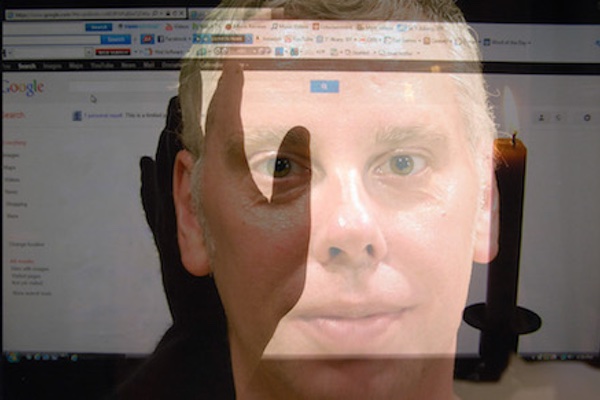On Logophilia and Process
By Stephen Mead
See his work in Vol IV. #7

Just as some have a natural proclivity for math or sports, I have had one for actual words since an early age. “Chrysalis” was a particular favorite, the name of an old Jethro Tull record – I remember the icon on the label, a lavender butterfly/moth with wings outspread, and how the word on my tongue could trigger a little frisson in my spirit.
Of course, back then, given the fact that this wasn’t really a word used in daily conversation –“Please pass the butter; I love it’s delicious chrysalis from cream”-–I remember blushing and feeling awfully stupid when I heard it spoken correctly. In my head, I was hearing cry (as in tears)- salis, sal (as in Sally)-is. “I would like some cry-sal-is in my salad please,” or even, “Have you met my friend, Cry– salis?”
It is a relief now to find humor in the meanings of expressions I have felt so deeply, taken so seriously; to be a buoy in the lightness of folly. This penchant for finding esoteric, multi-syllabic words, often with proper old English spellings (spectre as opposed to specter), came from the fact that, instead of a modern Oxford dictionary in the house, we had a thick dusty, red-cloth one dating back to 1911 or so.
Particular words have ways of thrumming in my mind, and it was years before I would realize poetry rather than fiction would be their best conduit. Back in high school, I spent a great deal of time working on both poetry and fiction, first in freehand, then typing on my mother’s old Corolla with keys that often stuck and left holes in the paper. It’s funny thinking back to that pre-digital age of blue carbon copies, the crisp chemical smell of fresh ink, and how literally physically frustrating (in addition to mentally) this process could be.
Most of that early writing has either been chucked or put in manila envelopes, what I think of as apprenticeship. While I was already writing poetry back then, I think I was still seeing myself as a fiction writer, even after graduating high school when I earned some money selling my record collection to pay an agent’s reading fee, only to be told that my novel just would not sell. I persisted with fiction, anyway, scribbling obsessively in journals, snatches of dialogues and character sketches, all while still writing poems and poem fragments.
Eventually I self-published a novel from the 1980s, Where Time Goes, via the new technology of CreateSpace in 2008. Another novel, Hang onto Your Own Teeth, actually written later in the 1990s, after I dropped out of college, was published in 2007 by similar means. Looking back at those fictional works, it strikes me as a sort of madness that, like the hundreds of poems I had been writing simultaneously, they went through lots of revisions–not only the crossing out of whole paragraphs, but the highlighting of a particular word to tie back in with another word somewhere else on the page, if not on a different page entirely. The drafts I have in many cases look like hieroglyphic maps, given the variety of colored inks or highlighters, scribbled-out lines with ones written above them or in the margins; arrows drawn to circled as well as numbered words and phrases, so I would know which ones should be typed first.
It would be some time still before I made that final parting from fiction in favor of poetry, but around 2001, perhaps with 911 being an unconscious emotional catalyst, I decided to try publishing again, this time with work that I like to think of as having been fermenting or germinating, becoming itself in a hidden place. Thematically I also began to see connections with a great deal of art I’d done, these explorations, a kind of conversation between one another. After another couple of geographic moves, and learning to be less emotionally drawn to the toxic in my relationships, that old “co-dependent-no more can-I-take-care-of-you-please-even-though-I-am-crawling-around-on-the-floor,” well-captured by photographers such as Nan Goldin, I somehow began to give myself permission to be content with the actual space that can be shaped by words and images, separately or together.
Eventually I would realize I just did not have the chops to be a Stephen King or, in a more literary way, John Irving. I simply was not intellectually capable of crafting a novel, whereas with poetry, never a “big seller” in any age, there can be the compressing of an epic into a tight strand of well-placed words; or there can also be the pleasure of taking time to see, live, and feel something as commonplace as a dandelion. In other words, as an anachronism, I tried (and still do) to make the reclusive best of it. Oddly enough, as I age I write less but revise more in my head, by carrying the piece around inside of me, letting it change/become more itself along the way. When I feel I will burst with it, the actual writing pours out.
Writing this piece now brings me back to the word chrysalis. It is the creative outcome, I believe, which ultimately has the right to exist, the outer world shaped by the inner one of metamorphosis. It is odd yet fascinating to think about, that creative evolution revving from the building blocks of cells, of molecules, of neurons firing between synapses, the crossing over of that energy and its output: these words, these images, the skein of the human spirit.
Copyright 2016 Woven Tale Press LLC. All Rights Reserved.

